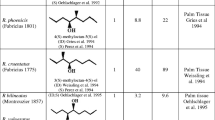Abstract
The population fluctuation of the red palm weevil, Rhynchophorus ferrugineus was studied, using the aggregation pheromone traps, during 2000 and 2001 in the United Arab Emirates. The insect population increased gradually from January to reach its peak in March, April, or May. The populations in three date palm plantations were much less in 2001 compared to 2000 with reductions of 29.7–51.7%. An evaluation of the performance of the pheromone traps showed that they could capture 4.4 to 20.7% of the resident populations of R. ferrugineus in the three different date palm plantations. No significant differences could be found in rates of capture between males and females. Individuals of marked weevils released in date palm plantations migrated 1–7 km from the plantations in which they were released. The released marked weevils were recaptured, mostly, within 3–5 days post release.





Similar content being viewed by others
References
Abbas MST, Hanounik SB, Mousa SA, Al-Bagham SH (2000) Soil application of entomopathogenic nematodes as a new approach for controlling Rhynchophorus ferrugineus on date palms. Inter J Nematology 10(2):215–218
Abbas MST, Hanounik SB, Mousa SA, Mansour MI (2001) On the pathogenicity of Steinernema abbasi and Heterorhabditis indicus isolated from adult Rhynchophorus ferrugineus. Inter J Nematology 11(1):69–72
Abraham VA, Nair SS, Nair CPR (1999) A comparative study on the efficacy of pheromone lures in trapping red palm weevil, Rhynchophorus ferrugineus in coconut gardens. Indian Coconut Journal Cochin 30(7):1–2
Bitton S, Nakache Y, (2000) Red palm weevil in Israel. Proceedings of date palm international symposium. February 22–25, 2000, Republic Of Namibia.
Chinchilla CM (1988) The red ring-little leaf syndrome in oil palm and coconut. Bol TecOpo-CB 2(4):113–136
Chinchilla CM, Oehlschlager AC, Gonzales LM (1993) On the management of red ring disease in oil palm through pheromone based trapping of Rhynchophorus palmarum 1993 Pipoc Porim International Palm Oil Congress "Update and Vision", 20–25 September 1993. Kualalumpur, Malaysia
Cox ML (1993) Red palm weevil, Rhynchophorus ferrugineus in Egypt. FAO Plant Protection Bulletin 41:30–31
EI-Garhy ME (1996) Field evaluation of the aggregation pheromone of Rhynchophorus ferrugineus in Egypt. Brighton Crop Protection Conference: pests & diseases: vol. 3: Proceedings of an international conference, Brighton, UK, pp 18–21
Gobinadhan PB, Mohandas N, Nair KPV (1990) Cytoplasmic polyhedrosis virus infecting red palm weevil in coconut. Curr Sci 59:577–580
Griffith R (1987) Red ring disease of coconut palm. Plant Dis 71:193–196
Hallett RH, Oehlschlager AC, Gries G, Angerelli NPO, AI-Shareqi RK, Gassuma MS, Borden JH (1993) Field-testing of aggregation pheromones of two Asian palm weevils 1993 Pipoc Porim International Palm Oil Congress "Update and Vision". 20–25 September, 1993. Kualalumpur, Malaysia
Hanounik SB (1998) Steinemematids and Heterorhabditids as biological control agents for the red palm weevil, Rhynchophorus ferrugineus. Sultan Qabus University J Scientific Res Agr Sci 3:95–102
Hanounik SB, Hegazy G, Abbas MST, Salem M, Saleh MME, Mansour MI, El-Muhanna 0, Al-Bagham S, Abuzuhaira R, Awash S, Shambia A (2000) Biological control of Rhynchophorus ferrugineus as a major component of IPM. Proc. lst Workshop on Control of date palm red weevil. 22–25 November 2000, AI-Ehsaa, Saudi Arabia pp 125–150
Kalshoven LGE (1981) Pests of crops in Indonesia. Jakarta, P.T. Ichtiar Baru-Van Hueve.701 pp
Muralidharan CM, Veghasia UR, Sodagar NN (1999) Population, food preference and trapping using aggregation pheromone on red palm weevil, Rhynchophorus ferrugineus. Indian J of Agr Sciences 69(8):602–604
Murphy ST, Briscoe BR (1999) The red palm weevil as an alien invasive:biology and prospects for biological control as a component of IPM. Biocontrol News and Information 20(1):35–46
Oehschlager AC (1996) Emergency assistance for date palm weevil control. FAO Second Mission Report. TCP EGY 4558
Peter C (1989) A note on the mites associated with the red palm weevil, Rhynchophorus ferrugineus in Tami Nadu. J Insect Sci 2:160–161
Rajamanickam K, Kennedy JS, Christopher A (1995) Certain components of integrated management for red palm weevil, Rhynchophorus ferrugineus on coconut. Mededlingen Faculteit Landbouwkundige-en-Toegepaste Biologische Watenschappen Universi-teit 60(3a):803–805
Rajan P, Nair CPR (1997) Red palm weevil–the tissue borer of coconut palm. Indian Coconut J Cochin 27(12):2–3
Acknowledgements
This study was carried out at AI-Hamraniya Research Station, Ras AI Khaimah, UAE, through the biocontrol project of red palm weevil supported by Arab Organization for Agricultural Development (AOAD) and funded by Islamic Development Bank (lOB) and International Fund for Agriculture Development (IFAD).
Author information
Authors and Affiliations
Corresponding author
Additional information
Communicated by W. Schwenke
Rights and permissions
About this article
Cite this article
Abbas, M.S.T., Hanounik, S.B., Shahdad, A.S. et al. Aggregation pheromone traps, a major component of IPM strategy for the red palm weevil, Rhynchophorus ferrugineus in date palms (Coleoptera: Curculionidae). J Pest Sci 79, 69–73 (2006). https://doi.org/10.1007/s10340-005-0113-6
Received:
Published:
Issue Date:
DOI: https://doi.org/10.1007/s10340-005-0113-6




